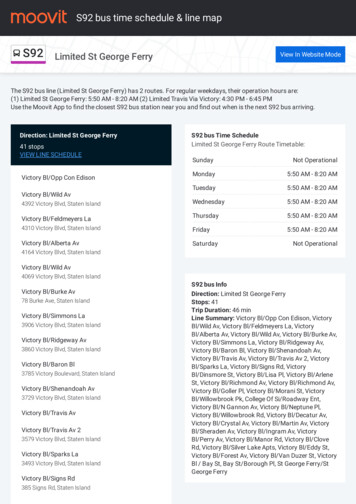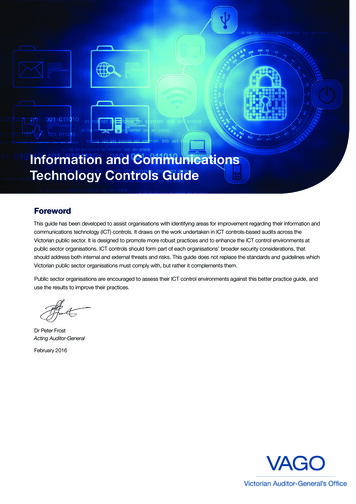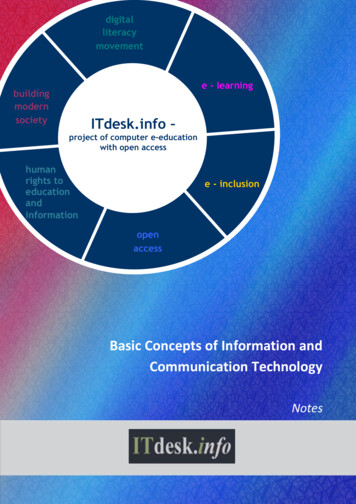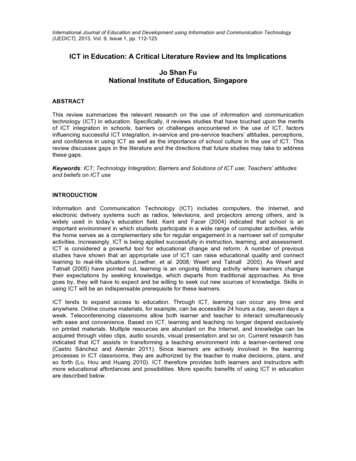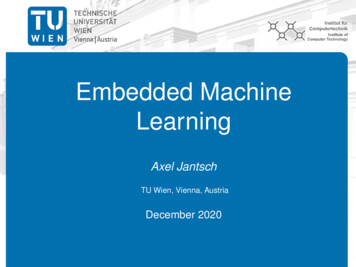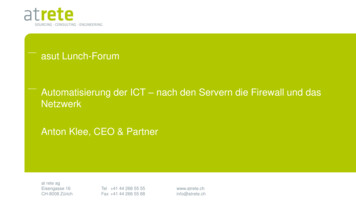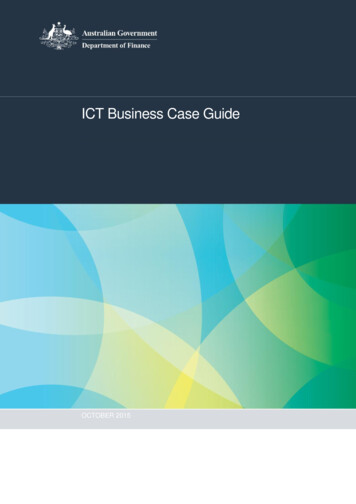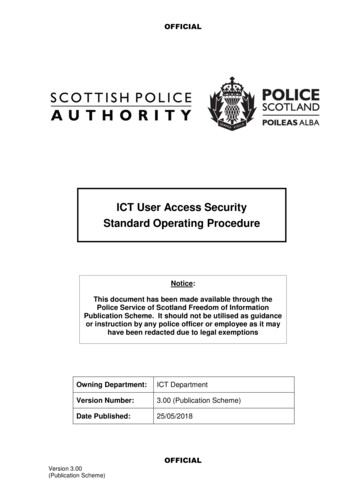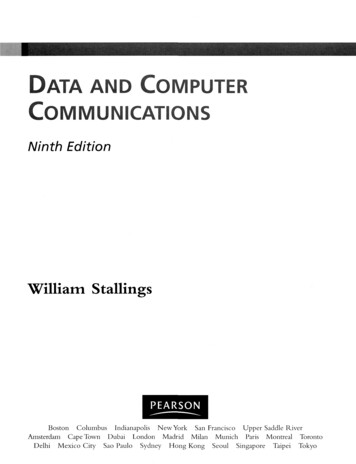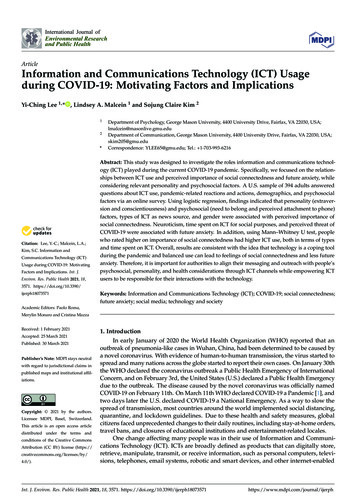
Transcription
International Journal ofEnvironmental Researchand Public HealthArticleInformation and Communications Technology (ICT) Usageduring COVID-19: Motivating Factors and ImplicationsYi-Ching Lee 1, * , Lindsey A. Malcein 1 and Sojung Claire Kim 212* Citation: Lee, Y.-C.; Malcein, L.A.;Kim, S.C. Information andCommunications Technology (ICT)Usage during COVID-19: MotivatingFactors and Implications. Int. J.Environ. Res. Public Health 2021, 18,Department of Psychology, George Mason University, 4400 University Drive, Fairfax, VA 22030, USA;lmalcein@masonlive.gmu.eduDepartment of Communication, George Mason University, 4400 University Drive, Fairfax, VA 22030, USA;skim205@gmu.eduCorrespondence: YLEE65@gmu.edu; Tel.: 1-703-993-6216Abstract: This study was designed to investigate the roles information and communications technology (ICT) played during the current COVID-19 pandemic. Specifically, we focused on the relationships between ICT use and perceived importance of social connectedness and future anxiety, whileconsidering relevant personality and psychosocial factors. A U.S. sample of 394 adults answeredquestions about ICT use, pandemic-related reactions and actions, demographics, and psychosocialfactors via an online survey. Using logistic regression, findings indicated that personality (extraversion and conscientiousness) and psychosocial (need to belong and perceived attachment to phone)factors, types of ICT as news source, and gender were associated with perceived importance ofsocial connectedness. Neuroticism, time spent on ICT for social purposes, and perceived threat ofCOVID-19 were associated with future anxiety. In addition, using Mann–Whitney U test, peoplewho rated higher on importance of social connectedness had higher ICT use, both in terms of typesand time spent on ICT. Overall, results are consistent with the idea that technology is a coping toolduring the pandemic and balanced use can lead to feelings of social connectedness and less futureanxiety. Therefore, it is important for authorities to align their messaging and outreach with people’spsychosocial, personality, and health considerations through ICT channels while empowering ICTusers to be responsible for their interactions with the technology.3571. https://doi.org/10.3390/ijerph18073571Keywords: Information and Communications Technology (ICT); COVID-19; social connectedness;future anxiety; social media; technology and societyAcademic Editors: Paolo Roma,Merylin Monaro and Cristina MazzaReceived: 1 February 2021Accepted: 25 March 2021Published: 30 March 2021Publisher’s Note: MDPI stays neutralwith regard to jurisdictional claims inpublished maps and institutional affiliations.Copyright: 2021 by the authors.Licensee MDPI, Basel, Switzerland.This article is an open access articledistributed under the terms andconditions of the Creative CommonsAttribution (CC BY) license (https://creativecommons.org/licenses/by/4.0/).1. IntroductionIn early January of 2020 the World Health Organization (WHO) reported that anoutbreak of pneumonia-like cases in Wuhan, China, had been determined to be caused bya novel coronavirus. With evidence of human-to-human transmission, the virus started tospread and many nations across the globe started to report their own cases. On January 30ththe WHO declared the coronavirus outbreak a Public Health Emergency of InternationalConcern, and on February 3rd, the United States (U.S.) declared a Public Health Emergencydue to the outbreak. The disease caused by the novel coronavirus was officially namedCOVID-19 on February 11th. On March 11th WHO declared COVID-19 a Pandemic [1], andtwo days later the U.S. declared COVID-19 a National Emergency. As a way to slow thespread of transmission, most countries around the world implemented social distancing,quarantine, and lockdown guidelines. Due to these health and safety measures, globalcitizens faced unprecedented changes to their daily routines, including stay-at-home orders,travel bans, and closures of educational institutions and entertainment-related locales.One change affecting many people was in their use of Information and Communications Technology (ICT). ICTs are broadly defined as products that can digitally store,retrieve, manipulate, transmit, or receive information, such as personal computers, televisions, telephones, email systems, robotic and smart devices, and other internet-enabledInt. J. Environ. Res. Public Health 2021, 18, 3571. mdpi.com/journal/ijerph
Int. J. Environ. Res. Public Health 2021, 18, 35712 of 14systems, including traditional media and social media [2–4]. For example, with regardto television use, during the week of March 16th of 2020, viewership of the four largestbroadcasts networks in the U.S. increased nearly 19% compared to the same week during2019. In terms of news consumption during the week of March 16th, viewership of cablenews networks increased 73% from 2019 to 2020 and increased 40% compared to the weekof February 17th of 2020. During the week of March 16th, number of digital visits to newswebsites in the U.S. increased by 68% and the number of digital visits to governmentsources (e.g., WHO) increased by 299% compared to the week of February 17th [5]. Inregard to cell phone usage, data collected in May 2020 from the U.S. suggested that peoplehave become more dependent on their phone service: 37% increase in texting, 36% increasein social media, 23% increase in the use of shopping apps, and 32% increase in videocalling [6]. Similarly, Zoom, Google Classroom, and Microsoft Teams have documented increased use of video calling during the first half of March [7]. Mobile, contactless paymentsand online food ordering have also seen increased use in tandem with social distancingmeasures [8,9].Empirical studies have also reported an increasing trend of ICT use and higher risk ofexcessive internet use during COVID-19 quarantine or lockdown [10]. The increased use ofICT can ultimately be associated with various physical, psychosocial, and mental healthoutcomes [11,12]. This increased use may be driven by disrupted daily routine, need fortelework and online schooling, anxiety due to uncertainty about the future, and need forentertainment, news, and social connectedness. Individual differences such as personalitytraits may also affect feelings about and responses to COVID-19 safety measures andsocial connectedness. This paper aimed to investigate the relationships among ICT use,social connectedness, and feelings about the pandemic. Relevant literature related to theconnection between ICT use and COVID-19 as well as the associated feelings about socialconnectedness and the future will be reviewed in the next section.2. Literature Review2.1. ICT Use during the PandemicEngagement with ICT during the COVID-19 pandemic has received mixed reporting.On the one hand, ICT facilitates the dissemination of information and facts about the diseasewhile allowing people to access and search for related updates [13]. Given the evolvingnature of the pandemic, the practical challenge is how to best transfer and deliver the latestinformation efficiently. Traditional methods of dissemination and communication, such asstatic websites and even email are considered slower than the use of news media and socialmedia [14]. For example, the use of educational materials and infographics via social mediahas been viewed as a speedier way of information dissemination compared to traditionalmethods [13,15]. Additionally, large scale working from home and online schooling hasbecome possible due to the use of ICT and other internet-enabled technologies [16–18].Similarly, telehealth services can provide feasible on-going or new treatment options viaonline means during the pandemic [19,20]. Staying socially connected with families andfriends and having access to virtual physical exercise materials and entertainment duringstay-at-home orders are realized through ICT [20,21], as these strategies are recommendedfor mental health by the WHO [22].However, the use of ICT can also be problematic. Among children and universitystudents, excessive screen time and limited outdoor activities during the pandemic have potential worrisome outcomes in relation to myopia [23], sedentary behaviors [24], disruptedsleep routines [25], and reduced physical activity [26], just to name a few. Adults alsoreport worse depression, loneliness, and stress being associated with increased screen timeand reduced physical activity [27]. These lifestyle changes during the pandemic have beenlinked to poor mental health [27], thus confirming the established association between excessive screen time and negative mental health outcomes from pre-pandemic times [28,29].Another downside of ICT use is related to the lack of in-person social interactions. Evenfor people who do not live alone, they may still feel lonely if their contact with others, such
Int. J. Environ. Res. Public Health 2021, 18, 35713 of 14as through the means of ICT during quarantines, does not provide a sufficient sense ofsocial connectedness [30]. In addition, with the amount of information about COVID-19that is available through various ICT channels, some people have expressed feelings ofinformation overload and fatigue [31,32], while, at the same time, having feelings of anxietyand uncertainty about the future and especially about how the pandemic will end [33].2.2. Social Connectedness during the PandemicOne consequence of COVID-19 and the associated social-distancing measures hasbeen accompanied by psychosocial implications, including increased risk of social isolationand loneliness [30]. Social isolation—the objective lack of interactions with others or thewider community [34]—even as short as 10 days, can have negative long-term effectsthree years later [35]. Loneliness—the subjective feeling of the lack of social networksor companions [34]—can be triggered by social isolation, or vice versa [36]. Prolongedsocial isolation and feelings of loneliness, characterized by reduced social connections andcontact, have been linked to reduced psychological and physiological functioning andincreased morbidity and mortality [37,38]. Therefore, public health agencies and cliniciansemphasize the importance of maintaining social contact during this pandemic for thepurpose of improving feelings of social connectedness and decreasing loneliness [30].Psychoactive substance use and other reinforcing behaviors such as video gaming,TV watching, using social media, gambling, and surfing the internet are often used toreduce anxiety and depression [10], but increased ICT consumption can also lead tonegative health outcomes, as have been observed during COVID-19 [27,39]. For example,one study investigated the impact of COVID-19 on online gambling during the week ofApril 21st, 2020 and found that individuals with higher levels of anxiety and depressionwere more likely to have gambled than individuals with no symptoms [40]. Among asample of adolescents and young adults across several countries, COVID-related worries,compulsive internet use, social media use, and gaming addiction predicted scores ofescapism, depression, and loneliness [41]. A study conducted during June 2020 found thatcollege students had excessive use of social networking sites and lack of personal controlto disengage themselves from those sites [42]; this tendency was also associated with theuse of alcohol, tobacco, cannabis, and sedative without a doctor’s prescription. Anotherstudy conducted in March and April 2020 in the U.S. suggested that exposure to COVID-19information, via Twitter, Instagram, and Facebook, and increased alcohol use in Marchcontributed to more frequent alcohol consumption in April, especially those working orstudying from home [43]. These empirical studies suggest that even though ICT provides ameans of social connection with one’s social networks and the wider community, moderateand responsible use is important in maintaining a healthy approach to it.Personality traits have also been linked to COVID-19 stress, coping, and concerns.Extraverts—compared to introverts—tend to have larger social network sizes [44] and thesenetwork connections can serve as a buffer during the pandemic [45]. Arguably, extravertsmay suffer more due to COVID-19 travel bans and restrictions on social gatherings. Anonline study conducted in late March and early April 2020 across 47 countries investigatedthe associations among the level of stringency of safety measures, extraversion, and depression [46]: Results showed that, after controlling for country-level factors, introvertswere doing better in terms of depressive symptoms when facing stringent social-distancingmeasures, but the stringent measures only had limited, non-significant effects on extraverts’depressive symptoms. Other aspects of personality traits were also examined: using anadult sample collected in late March 2020 from the U.S., individuals higher on neuroticismand lower on conscientiousness had more pandemic-related concerns, especially healthrelated concerns; however, individuals higher on neuroticism and extraversion had morerelationship-related concerns [47]. Higher conscientiousness was associated with moreprecautious behaviors (such as hand washing) to avoid contracting COVID-19 but fewerpreparatory behaviors (such as buying face masks). However, older individuals who werehigher on conscientiousness had more preparatory behaviors. In terms of estimates of
Int. J. Environ. Res. Public Health 2021, 18, 35714 of 14the pandemic duration, individuals higher on neuroticism had a more negative feelingabout the pandemic (i.e., longer duration), but individuals higher on extraversion andconscientiousness had more optimistic estimates [47]. These findings shed some light onthe associations between personality traits and behaviors related to COVID-19; however,other aspects of behavioral and psychosocial responses, such as social connectedness in thecontext of ICT use and its relation to personality, have not been widely explored.ICT plays an important role in helping people adapt to restrictions on in-persongatherings. Many organizations in the public, private, and philanthropic sectors havedeveloped messaging and outreach programs to specifically promote social connectionsand reduce loneliness via emails, websites, or smart phone applications. ICT serves ascommunication channels and social interaction media between sources of informationand receivers. Although online interactions—both on the giving and the receiving ends—can foster a sense of connection, there is conflicting evidence about the role ICT plays inenhancing the feeling of social connectedness during the COVID-19 pandemic. This paperwas designed to further investigate this open question.2.3. Feelings About the Future during the PandemicAt the time of writing, the pandemic is still ongoing and affecting people’s livesholistically. While the prospect of a vaccine provides a sense of relief for some, there isstill a lot of anxiety and uncertainty about when and how the pandemic is going to endand whether lives will return to the pre-pandemic normal. These feelings are not easy totease apart, as they are deeply intertwined with the economic, societal, and psychologicalconsequences of the pandemic [48].These feelings are also related to the perceived threat of the pandemic. An onlinestudy conducted in June 2020 during a lockdown measure investigated the relationshipsamong perceived threat of COVID-19, future anxiety, and subjective well-being [49]. Results indicated that perceived threat negatively predicted subjective well-being, and thisrelationship was mediated by anxious feelings about the future. Another online study conducted in early May 2020 investigated the relationships among personality traits, perceivedstress during the pandemic, perceived threat of contracting COVID-19, and perceivedefficacy to prevent COVID-19 [50]. Results showed that higher neuroticism was associated with higher levels of pandemic-related stress, and this relationship was mediated byperceived threat and efficacy. Similarly, higher extraversion was associated with higherpandemic-related stress.There have also been studies that examined the effect of media exposure on COVIDrelated fear and worries. An online study conducted in mid-March 2020 investigated therelationships among fear of COVID-19, intolerance of uncertainty, worry, anxiety, personalrelevance of the threat, and media exposure (sources of COVID-19 information); resultsindicated that media exposure through regular and social media, tendency to worry abouthealth, and risk for loved ones predicted increased fear of COVID-19 [51]. Another studyconducted in early April 2020 had participants recall their media sources (i.e., government,commercial, foreign, and social media) from late January to February during the pandemicin China while responding to questions about media traumatization and anxiety due tothe pandemic. Most of the survey respondents spent 1-3 h per day watching or hearingCOVID-19 information and repeated media exposure led to higher levels of anxiety as wellas media traumatization [52]. These findings suggest that the subjective feelings aboutthe pandemic, such as anxiety, may be influenced by a number of psychosocial factors,personality traits, and media exposure. This paper was designed to further investigate theinfluence of media types for news information or social purposes on subjective feelingsabout the pandemic.2.4. Study ObjectivesBased on the past literature, this paper focused on two consequences of ICT use duringthe pandemic: social connectedness and feelings about the future. Specifically, we explored
Int. J. Environ. Res. Public Health 2021, 18, 35715 of 14how ICT use, behavioral and psychosocial responses during the pandemic, personalitytraits, and demographic factors influenced perceived importance of social connectednessand perceived future anxiety.3. Materials and MethodsAn online, anonymous survey was used for this work. This study received theInstitution Review Board approval from the authors’ university. This survey was posted onMechanical Turk during the afternoon of April 21st and the morning of April 22nd, 2020;during this time, 42 states and territories in the U.S. had issued mandatory stay-at-homeorders [53].3.1. ParticipantsIndividuals who were Amazon Mechanical Turk workers and held the status of aMaster [54] (workers who have demonstrated high performance over time and meet theperformance requirements put forth by Mechanical Turk) were invited to participate. Otherinclusion criteria included being an adult (18 years of age or older) and residing in the U.S.A total of 402 participants completed the survey and received the compensation of USD 7.Eight of them provided at least one invalid answer to the three attention check questions(e.g., answering 1978 when the survey asked for the current year, answering February whenthe survey asked for the current month) and were removed from the dataset; therefore, thefinal sample size was 394.3.2. ProcedureIndividuals who chose to take part would first read the consent page and must agreeto the requirement of completing the entire survey. Once they indicated consent, theyread the instructions as well as the definitions of the terminology (e.g., ICT) used in thesurvey. The instructions also emphasized that there were no right or wrong answers andthat participants were asked to answer the survey questions honestly. Participants saw onequestion at a time and were encouraged to answer all the questions, although they couldskip questions if they chose to. At the end of the survey, participants were encouraged toleave comments and feedback about the survey and report any technical issues during thestudy. On average, participants took 16 min to complete the survey.3.3. Key MeasuresThe survey was programed in Qualtrics software (see Supplementary Materials forthe survey items). About half of the items were previously validated psychosocial scales:The Need to Belong Scale [55], the Fear of Missing Out Scale [56], Perceived Attachment toPhone Scale [57], Habitual Smartphone/Internet Behavior Scale [58,59], the Self RegulationScale [60], the Boredom Proneness Scale [61,62], and the Abbreviated version of the BigFive Inventory [63]. The rest of the survey items were developed by the authors and aredetailed below.3.3.1. Information and Communications Technology (ICT)There were 6 questions about the ICT. ICT was defined as “the integration of telecommunications and computers as well as necessary software, hardware, and audiovisualsystems that enable users to access, store, transmit, and manipulate information and to communicate in a digital form.” These questions were about (1) overall ICT devices used on adaily basis, (2) time spent using ICTs for obtaining news on a daily basis, and (3) the sourcesfor obtaining news on a daily basis (e.g., news channels, radio, etc.). These questions werepresented twice—for participants to indicate their answers from two time periods: beforethe pandemic and during the pandemic.
Int. J. Environ. Res. Public Health 2021, 18, 35716 of 143.3.2. Reactions Related to the PandemicThere were 3 questions about the reactions related to the pandemic. One questionasked participants to rate their feeling after reading or hearing the news about the pandemic. A second question asked whether the participants considered the current pandemicsituation a threat to their health and safety. Another question asked whether they think thenews conveyed the current pandemic situation correctly.3.3.3. Actions Related to the PandemicThere were 4 questions about the actions that have been taken as the result of thepandemic. Two questions asked whether participants took actions about the pandemicand what the actions were (e.g., social distancing). Another set of questions asked forthe time spent on applications (e.g., social media, email, etc.) for the purpose of stayingconnected with their social network as well as the importance of staying connected withfriends, family, and social networks.3.3.4. Demographic QuestionnaireThere were 8 questions. These items asked for participants’ age, gender, residence,state of residence, race and ethnicity, education, income, and employment status.3.3.5. Attention Check QuestionsThree attention check questions were included in the survey. They were added to helpidentify inattentive participants and to provide progress status, as they appeared after eachquarter (1/4, 1/2, and 3/4) in the survey.3.4. Analytic StrategyA few additional variables were calculated to answer the proposed research questions:(1) Types of ICT devices used on a daily basis: participants could check all that apply from11 options (e.g., Computer for non-internet use, Computer for internet use, Cable TV, etc.)and write in additional items. These types were then added to reflect the overall totaltypes of devices used. These steps were used for the before and during pandemic periods.(2) Types of ICT as news sources about what is happening on a daily basis: participantscould check all that apply from 8 options (e.g., Social media, TV news channels, Radio, etc.)and write in additional items. These types were then added to reflect the overall total typesof sources. These steps were used for the before and during pandemic periods. (3) Averagehours spent on using applications and systems for the purpose of staying connected withsocial networks on a daily basis: participants used a sliding bar to indicate the hours forsocial media, telecommunication, and email and had the options to write in two additionalitems and then indicate the hours. These hours were then averaged across the items toreflect the average hours spent daily for virtually staying connected with social networks.To answer our first research question, a logistic regression was used to model the relationship between the perceived importance of social connectedness (low vs. high) and thepsychosocial, ICT use, and demographic variables. To answer our second research question,a logistic regression was used to model the relationship between participants’ feeling aboutthe future (positive vs. negative) and the psychosocial, ICT use, and demographic variables.A non-parametric Mann–Whitney U test was used to compare the distributions ofresponses due to the non-normality of our data distribution. Correlations of the variableswere checked and there was no evidence of multicollinearity (all the Spearman correlationcoefficients were smaller than 0.6). SPSS version 26 was used for the analyses.4. Results4.1. Sample CharacteristicsThe sample consisted of 219 men and 175 women in the U.S., with ages ranging from20 to 76 and the average being 40.89 (SD 11.21) years. The participants came from all ofthe states, except Alaska, Arkansas, North Dakota, South Dakota, and Vermont. In terms of
Int. J. Environ. Res. Public Health 2021, 18, 35717 of 14primary residence, 190 indicated suburban areas, 125 indicated urban areas, 77 indicatedrural areas, and 2 chose other. The majority of the participants identified their race andethnicity as White (n 307) (61 as Asian, 20 as Black, 12 as Hispanic/Latino/Spanish origin,11 as American Indian/Alaska Native, 1 as Native Hawaiian/Other Pacific Islander, and2 as Other). As for education level, most of participants reported having a college degree(n 219), followed by having some college (n 70), having a graduate degree (n 56),having a high school diploma (n 47), and having some high school education (n 2). Theannual household income item included five options: most of participants selected the45 K–70 K (n 115) and 25 K–45 K (n 105) options, followed by the 70 K–110 K option(n 69), 25 K option (n 62), and 110K option (n 43). Most of them currently hada full-time job (n 258) (22 worked part-time, 82 were self-employed, 3 were a student,27 were unemployed). The statistics of the psychosocial scales are listed in Table 1.Table 1. Statistics of the psychosocial scales.ScalesMeanSDCronbach’s AlphaNeed to belongFear of missing outPerceived attachment to phonesHabitual smartphone/internet behavior—SmartphoneHabitual smartphone/internet behavior—InternetSelf regulationBoredom proneness—Lack of internal stimulationBoredom proneness—Lack of external stimulationAbbreviated version of the big five—ExtraversionAbbreviated version of the big five—AgreeablenessAbbreviated version of the big five—ConscientiousnessAbbreviated version of the big five—NeuroticismAbbreviated version of the big 900.810.810.760.670.630.790.60Almost all of the participants (n 391) indicated that they actively took actions aboutthe current pandemic situation (e.g., social distancing, working from home, etc.). Themajority of them thought that the news correctly conveyed the current pandemic situation(n 308) and that the current pandemic situation was a threat to their health and safety(n 315). Slightly less than half of the participants rated their feeling about the pandemicupon reading the news as “Positive—it’s going to be ok” (n 181), while the rest felt“Negative—it’s not going to be ok.”4.2. Importance of Social ConnectednessIn answering our first research question, one survey item asked about the importanceof staying connected with friends, family members, and social networks. Participantsrated from not at all important to extremely important. Given the uneven distributionof the rated responses (see Figure 1), this variable was dichotomized to reflect two levelsof importance: low (combined from “not at all important,” “slightly important,” and“moderately important”) and high (combined from “very important” and “extremelyimportant”) importance, having n 192 and 202, respectively, in each level. Using thisdichotomized importance as the grouping variable, Mann–Whitney U test suggested thattypes of ICT devices used and types of ICT as news source were higher in the highimportance group for both before and during pandemic periods. Hours spent on ICTsfor obtaining news before the pandemic were not different between the low-and highimportance groups; however, hours were higher in the high-importance group during thepandemic (see Table 2).
Int. J. Environ. Res. Public Health 2021, 18, 35718 of 14Figure 1. Response distributions for the importance of the social connectedness variable.Table 2. Comparison of information and communications technology (ICT) use variables betweenlow- and high-importance groups.Type of ICT use—before pandemicType of ICT use—during pandemicType of ICT as news source—before pandemicType of ICT as news source—during pandemicHours of ICT—before pandemicHours of ICT—during pandemicLow-Importance:Mean (SD)High-Importance:Mean (SD)U TestSig.4.51 (1.67)4.59 (1.68)2.43 (1.24)3.04 (1.49)2.81 (3.45)4.52 (4.10)4.96 (1.56)5.09 (1.52)3.14 (1.53)3.99 (1.73)3.12 (3.70)5.40 (4.31)165071620714334133521841416285 0.01 0.01 0.001 0.0010.37 0.01Subsequently, a logistic regression was used to model the relationship between theperceived importance of social connectedness (low vs. high) and the psychosocial, ICTuse, and demographic variables. These variables were entered in three blocks, with block1 consisting of psychosocial variables, block 2 consisting of ICT use variables, and block3 consisting of demographic variables. Insignificant variables were removed with eachiteration. The final model had a Nagelkerke R of 0.36 and a Hosmer and Lemeshow Test ofχ2 (8, N 394) 11.55, p 0.17, indicating a good fit to the data. The classification accuracywas 68.80% for predicting low-importance and 76.70% for predicting high-importance, withthe overall accuracy being 72.80%. Table 3 sho
2019. In terms of news consumption during the week of March 16th, viewership of cable news networks increased 73% from 2019 to 2020 and increased 40% compared to the week of February 17th of 2020. During the week of March 16th, number of digital visits to news websites in the U.S. increa
